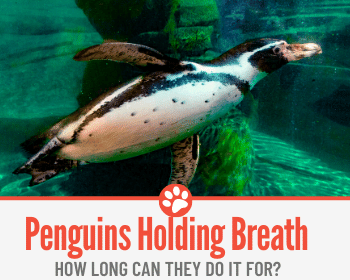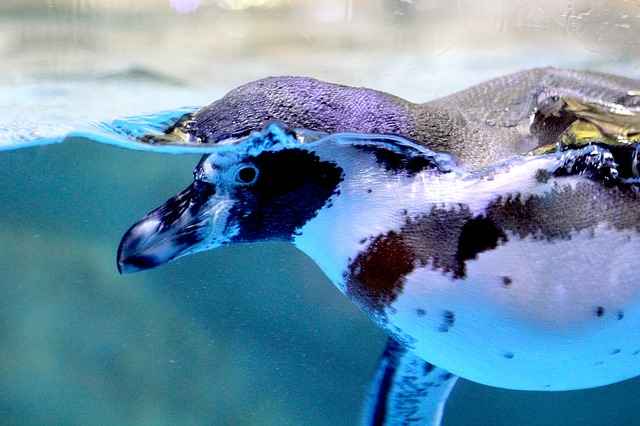 As you are probably are aware, Penguins can swim- amazingly fast using their super strong slippers!
As you are probably are aware, Penguins can swim- amazingly fast using their super strong slippers!
However, one main question is, how long can they hold their breath underwater?
They obviously can’t breathe underwater, therefore, how long can they survive whilst hunting for fish down below?
In this article, we will Discover Just that and See How long they can stay Underwater.
How Long Can Penguins Hold Their Breath?
Most Penguins can hold their breath for around 20minutes, there are however few penguin species such as African , Adeile or Macaroni Penguins which can only hold their breath to dive for food only for 3-5minutes.
Penguins need to hold their breath in order to hunt for their main prey which is fish. In order to hunt for fish, Penguins must dive underneath the water to collect fish. The penguins eat on average around 6kg of fish per day- meaning most penguins will dive under 200 times a day!
These creatures have lungs rather than gills- therefore, they must be careful, or their lungs could fill up with water- and they might die! Therefore, when a Penguin hunts for fish, it will regularly pop its head out for fresh air.
How Long Can Emperor Penguins Hold Their Breath For?
The largest of all Penguins is the Emperor Penguin (Genus Aptenodytes Type Forsteri), these beastly birds stand on average at 45 inches tall! Emperor Penguins can dive to an awesome depth of 1800 feet (550 meters), whilst holding their breath for 20-22 minutes!
That is 10-11 times the average maximum a Human can hold their breath for (2 minutes). These penguins are the diving champions- no other animal can dive that deep and keep their breath for that long.
It is mind blowing!
So how does the Emperor Penguin manage to do this amazing feat? When the Emperor Penguin dives, their oxygen usage is massively reduced- therefore, their heart rate drops to 15-20 Beats Per Minute.
This allows the Emperor Penguin to conserve its energy for hunting.
Furthermore, the bones of an Emperor Penguin are solid. This means it can survive the pressure exerted onto the penguin from the water- which is usually 40 times more than the surface.
This reduces the risk of Barotrauma- which is body tissue damage caused by large amounts of pressure emitted to an area of the body (e.g. divers would get this via their mask).
King Penguins
King Penguins (Genus Aptenodytes Type Patagonicus), are the second largest Penguins. These Penguins tend to dive 300 feet (100 meters) under the water. However, it has been reported some King Penguins have gone down even further (such as 300 meters 1000 feet)!
They can hold their breath for 20 minutes on average. They do look like Emperor Penguins; however, they do stand shorter at a male height of 29 to 39 inches.
Like an Emperor Penguin, they have solid bones. This helps with the pressure which is forced onto them from the water. They also conserve oxygen like Emperor Penguins, so they can comfortably hunt under the water for large periods of time.
African
African Penguins (Genus Spheniscus type Demesrus), are ridiculously small endangered Penguin mainly found within the South African regions. They look incredibly unique, and you will not get them mixed up with other penguins. They grow to around 24 to 28 inches tall.
They swim as deep as 400 feet which is 122 metres. However, what makes these penguins so unique is that they can only spend two and a half minutes under water!
That is crazy! Other penguins can hold their breaths for crazy amounts of time- whilst this small African Penguin can only do it 30 seconds more than the average maximum for a human!
However, they do dive at 12 mph which is far faster than most penguins- which results in them being able to hunt very quickly. Furthermore, these penguins are very agile and can move like a bullet.
Rockhopper
Rockhopper penguins, are usually treated as a single species- however some people split them into three separate species. Not all experts can agree on the species and the types.
However, they do have a very distinctive look. At full growth they reach 20 inches in height. These penguins can easily spend 20 minutes underneath the water hunting for fish- eating them whole!
These penguins then, do like to spend a lot of time under water. Like King and Emperor Penguins then- since their lungs also have an extremely high capacity.
They may dive down to a depth of 160 feet which is 49 metres. Not too deep then, however they can easily spend a long time down there hunting for fish.
Gentoo
Gentoo Penguins (Genus Pygoscelis type Papua). Their prey mostly resides within the upper parts of the water- therefore they only must spend five to six minutes to catch all the fish they need.
However, if they wish- they can spend an extra 14 to 15 minutes underwater. Totalling 20 minutes. These penguins can grow up to twenty to ninety centimetres tall (twenty to thirty-five inches) tall.
This makes them the third largest species of Penguin after King and Emperor.
These Penguins are the fastest swimming Penguin- reaching speeds of 22mph!
Chinstrap
Chinstrap Penguins (Genus Pygoscelis type Antarcticus) which grow to a maximum of 68 to 76 cm tall (27-30 inches). They can get very tall then, and they also spend a lot of time hunting.
These penguins can spend 20 minutes underwater, without needing a single breath! This makes it easier to hunt fir their prey.
Adeile
Adeile Penguins can grow to a maximum height of 46 to 71 cm (18 to 28 inches). These Penguins look remarkably like the ones you will see on the movie Happy Feet. Furthermore, these Penguins can only spend six minutes underwater- holding their breath.
Although, they regularly swim to depths of 150m (493 feet), their lung capacity is not as high as some other penguins. However, they can dive deeper if they wish collecting more fish. They are a lot faster thus, replacing the need to have such high lung capacities.
Galapagos
Probably the most famous species of Penguin and one of the most famous animals in the world! Seen on many of Sir David Attenborough’s TV documentary shows, millions of people worldwide have heard about these.
In fact, Darwin wrote a lot about the Galapagos islands, and it is most likely, you would have studied these Penguins in school. Many naturists have spoken about these Penguins.
Why are these Penguins so famous then? Well they are very threatened and becoming extinct and their name is derived from the hugely biodiverse island of Galapagos, where Charles Darwin spent a lot of time studying different organisms.
They are very small- and in some positions in which they swim in, they look like a duck. Their length is 49 centimetres (19 inches). These Penguins can stay 20 minutes underwater, holding their breath- searching for fish. They can swim at 15 mph and swim to depths of 458 cm (15 feet).
Macaroni
These penguins do look very funny. Their name is very funny. However, they are incredibly unique. First, their head has a macaroni style piece- that is known as a Crest and it is usually orange or yellow. That is an easy telling sign of what species this penguin is- it is extremely distinctive!
These Penguins can only hold their breath for up to three minutes. Sounds disappointing. However, they can dive as deep as 15 to 70 meters deep (49 feet to 230 feet). They can swim at speeds between 10mph and 15mph.
How Do Penguins Breathe?
Penguins have a very sophisticated breathing system. They can easily take in gallons of air at a time when they pop out their head from the water- inhaling and exhaling rapidly!
When they do take a big breath in, it is stored within their air-sacs rather than their lungs. This means they do not have to keep coming up and down like humans for oxygen. Thus, this results in a higher time spent under the water hunting for fish.
There is a technique, like Dolphins, which Penguins use. It is called Porpoisng. This consist of rapidly coming up for air- then exhaling it.
Can Penguins Breathe Underwater?
Unfortunately, not. They do not have gills therefore do not have this ability. They can hold their breathe for extended periods of time, but they cannot breathe underwater.
Therefore, they are like humans then- as if Penguins tried to breathe underwater, they would need air immediately, and their lungs will become full of water- essentially drowning.

How Do Penguins Stay Under Water
Penguins must take in a lot of air and hold it for an extended period when they go into the water. They get constant energy, as when they swim- they eat.
They keep their mouths open, and all prey (fish and other small seafood types), are swallowed whole by the penguin. The penguin can usually swim amazingly fast underwater, and swim at such depths most people would need oxygen tanks for!
They also conserve oxygen when diving, as they use less oxygen- therefore a lower BPM.
How Deep Can Penguins Dive
Penguins can dive to extraordinary depths! You have Emperor penguins going deeper than 1000 feet, then you have other penguins not even touching 100!
Either way, these creatures can swim extremely deep into the unknown! On average it is between 100 to 300 feet. Larger penguins tend to dive deeper however, smaller penguins tend to dive much faster.
Related Questions.
Are Penguins Waterproof?
Like all birds, Penguins have feathers. The outer part is waterproof- keeping it warm, whilst it searches through the cold, icy waters. The inner part of the feather traps warm air- allowing the penguin to dive so much deeper!
They need to be waterproof, as going into cold waters without any protection- can result in cramps, spasms and injury.
Therefore, this simple waterproofing adaptation by the Penguins allows them to hunt comfortably!
How Fast Do Penguins Swim?
Penguins on average tend to swim between 3 to 4 mph. However, some swim much faster, with the fastest penguins reaching speeds of 15 to 22 mph!
Speed really depends on how dynamic the penguin is and how it can use its flippers. More nimble agile penguins are more likely to reach faster speeds, since they produce less drag and can easily cut through the water.
In Conclusion
Penguins can dive very deep! Crazy depth levels, which are outstanding! Some swim at ridiculous speeds, whilst others a lot slower.
Penguins are very majestic creatures, which unfortunately are threatened. Many Penguins face extinction due to Climate Change.
These beautiful majestic birds cannot fly as such- but can swim very well! Their flippers are very agile, and their waterproof system is very sophisticated.






